Possible causes of blood in stool include:
Diverticular disease. Diverticula are small pouches that project from the colon wall. Usually diverticula don't cause problems, but sometimes they can bleed or become infected.
Anal fissure . A small cut or tear in the tissue lining the anus similar to the cracks that occur in chapped lips or a paper cut. Fissures are often caused by passing a large, hard stool and can be painful.
Colitis . Inflammation of the colon. Among the more common causes are infections or inflammatory bowel disease.
Angiodysplasia. A condition in which fragile, abnormal blood vessels lead to bleeding.
Peptic ulcers . An open sore in the lining of the stomach or duodenum, the upper end of the small intestine. Many peptic ulcers are caused by infection with a bacterium called Helicobacter pylori (H. pylori). Long-term use or high doses of anti-inflammatory drugs such as aspirin, ibuprofen, and naproxen can also cause ulcers.
Polyps or cancer . Polyps are benign growths that can grow, bleed, and become cancerous. Colorectal cancer is the third most common cancer in the U.S. It often causes bleeding that is not noticeable with the naked eye.
Esophageal problems. Varicose veins of the esophagus or tears in the esophagus can lead to severe blood loss.
cigarette smoke leads to
increased mucus production but low activity of cilia and machophage function.
morphine chronic use can be lethal due:
metabolization of morphine leads to active metabolites that acumulate.
(eg:Morphine-6-glucuronide (M6G) is a major active metabolite of morphine, and as such is the molecule responsible for much of the pain-relieving effects of morphine and heroin)
caution of chronic use of morphine in severe ill patients due:
kidney impairment would result in accumulation of the kidney-excreted active agent M6G, leading to potentially fatal toxicity such as respiratory depression. The frequent use of morphine in critically ill patients, and the common occurrence of kidney failure in this group implied that M6G accumulation could be a common
Two major theories of opioid tolerance involve:
changes in opioid receptors. One theory purports that receptors undergo changes that result in decreased receptor activation, or desensitization, with prolonged exposure to opioids. The other line of evidence suggests that opioid receptor down-regulation is at least partially responsible for the development of tolerance.
more: http://www.medscape.com/viewarticle/562216_3
Lamelar bodies where do you find?
Lungs! lamellar granules (otherwise known as membrane-coating granules (MCGs), lamellar bodies, keratinosomes or Odland bodies) are secretory organelles found in type II pneumocytes and keratinocytes. Lamellar granules fuse with the cell membrane and release pulmonary surfactant into the extracellular space.
Epidermis!In the upper spinous layer and stratum granulosum layer of the epidermis, lamellar bodies are secreted from keratinocytes, resulting in the formation of an impermeable, lipid-containing membrane that serves as a water barrier and is required for correct skin barrier function. These granules release components that are required for skin shedding (desquamation) in the uppermost epidermal layer, the stratum corneum
what is the 5' untranslated region (5′ UTR) ?
(also known as a Leader Sequence or Leader RNA) is the region of an mRNA that is directly upstream from the initiation codon. This region is important for the regulation of translation of a transcript by differing mechanisms in viruses, prokaryotes and eukaryotes
The prokaryotic 5′ UTR contains a ribosome binding site (RBS), also known as
the Shine Dalgarno sequence (AGGAGGU), which is usually 3-10 base pairs upstream from the initiation codon.[5] In contrast, the eukaryotic 5′ UTR contains the Kozak consensus sequence (ACCAUGG), which contains the initiation codon.[5]
Cap-independent translation of poliovirus mRNA is conferred by sequence elements within the
5 UTR
which allows for translation initiation in an end-independent manner, as part of the greater process of protein synthesis??
In eukaryotic translation, initiation typically occurs at the 5' end of mRNA molecules, since 5' cap recognition is required for the assembly of the initiation complex.
An internal ribosome entry site, abbreviated IRES, is a RNA element
The location for IRES elements is often in the 5'UTR of Rna virus!, but can also occur elsewhere in mRNAs.
the diference in risk between exposed and unexposed groups or proportion (%) of disease ocurrences that are attributable to the EXPOSURE.
treatment rate - control rate
Ie-Ine (incidence of disease/effect.. in exposed to treatment - non exposed_)
if the risk of lung cancer in smokers is 21% and risk in non smokers is 1%,then 20% of lunk cancer is attributable to smoking.
AR (attributable Risk)
also AR %: 100x(RR-1)/RR
the proportion of risk reduction attributable to the INTERVENTION as compared to control.
if 2% of patients develop the flu,while 8% develop without vacine.then RR=2/8=.025 (Ie/Ine)
and ...RRR= 1-RR= .75
the diference in risk (not proportion) atributable to the INTERVENTION as compared to control
control rate - treatment rate.
(Ine-Ie)
ARR
if 8% receive placebo vaccine develop flu X 2% receive flu vaccine develop flu
8%-2%=6%
presence og genetically distinct cell lines in the same individual.
term and disease example
Mosaicism
Mccune Albright syndrome
mutation affecting G ptn signaling= unilateral cafe au lai spots
polyostotic fibrous dysplasia,precocious puberty
multiple endocrine abnormalities.
lethal if mutation occur before fertilization (affecting all cells)
Mccune albright syndrome features
mutations arise from mitotic errors after fertilization and propagates through multiple tissues and organs
somatic mosaicism
mutation only in egg or sperm cells
gonadal mosaicism
one gene contribute to different phenotype affecting multiple organ system
pleiotropy
(PKU)
2 hit hypothesis remember
loss of heterozigozity
BRACA1 gene do not always result in breast ,ovarian cancer
incomplete penetrance
presence of normal and mutated mtDNA resulting in variable expressivity of mitocondrial inherited disease
heteroplasmy
phenotype varyes among individuasl with same phenotype (NF1)
variable expressivity
mutations at different LOCI can produce similar phenotype
mutations at same LOCI can produce similar phenotype
LOCUS heterogeneity: albinism
allelic heterogeneity: B thalassemia
can result is miscarriage,stillbirth and chromossomal imbalance (down,patau syndrome)
unbalanced translocation
Translocations can be reciprocal (balanced or unbalanced) or nonreciprocal (robertsonian)(balanced or unbalanced). give examples?
Reciprocal translocations are usually an exchange of material between nonhomologous chromosomes. are usually harmless and may be found through prenatal diagnosis. However, carriers of balanced reciprocal translocations have increased risks of creating gametes with unbalanced chromosome translocations, leading to miscarriages or children with abnormalities.
2 typer of chromossomal reciprocal translocations:
chromosomal translocations occurring in gametogenesis, due to errors in meiosis, and translocations that occur in cellular division of somatic cells, due to errors in mitosis. The former results in a chromosomal abnormality featured in all cells of the offspring, as in translocation carriers. Somatic translocations, on the other hand, result in abnormalities featured only in the affected cell line, as in chronic myelogenous leukemia with the Philadelphia chromosome translocation.

Robertsonian translocation is a type of translocation caused by
breaks at or near the centromeres of two acrocentric chromosomes(six acrocentric chromosomes: 13, 14, 15, 21, 22 and the Y chromosome).
The reciprocal exchange of parts gives rise to one large metacentric chromosome and one extremely small chromosome that may be lost from the organism with little effect because it contains so few genes. The resulting karyotype in humans leaves only 45 chromosomes, since two chromosomes have fused together
diseases with congenital MICROscopic deletion of:
short arm of 5
long arm of 7
5: Cri du chat syndrome (46 XX or XY,5p-)
7:Williams syndrome
microcephaly with intelectual disability,epicantal folds,cardiac abnormalities(VSD),
Cri du chat! cat like cry!
delected region gene of elastin, distinctive elfin fascies,intelec disab, hyper CALCEMIA (high sensitiity to vit D) WELL developed verbal skilss!!extreme friendliness with strangers! CV problems.
williams!
-microdeletion of chromosome
-deletion of chromosome:
-codon deletion
-single gene deletion
-above
- turner
-CF
- prader/angelman
GRAM + stain 3 divisions:
Cocci
rods(bacilli)
branching filaments
cocci next
catalase
+ staph -> coagulase -> + Aureus
- novobiocin sens: epidermidis X saprophyticus
- strep
rods: CCBL
Clostridium,corynebacterium,bacillus(aerobe),listeria
Branching filaments
Actinomyces (A naerobe,NOT acid fast) X
Nocardia
GRAM - stain
cocci (diplo)
coccoid rods
Rods
curved rods
maltose fermenter
N meningitis
coccoid rods HP BB
haemophilus, pasteurela, Bordetella pertussis, Brucella
Rods begins with -
lactose fermenter(pink color)
fast: KEE CS
Klebsiella,E.coli,enteroBACTER
slow: citrobacter, serratia
lactose non fermenter, use oxidase because is white/colourless!
oxidase - X +
oxidase +: pseudomonas motile encapsuled or aeromonas hydrophila
oxidase -: next TSI agar
TSI agar (triple sugar iron) produces H2S -Black ?bacterias
spy!
Salmonella
proteus
Yersinia
do not produce:
shiiiiiiigella
patient has burning abdominal pain that occurs 1-2 hours after patient eats. suspect:
duodenal ulcer due arrival of acid food!
usually the pain relieves when patient eats due release of pancreatic alkaline secretion
patient has burning abdominal pain worsening when eating! fear of eat!
stomach ulcer due increased acid secreations released
patient wit 6 month history of burning abdominal pain that occurs 1 to 2 hours after he eats.he also has Black stools for 2 days!
suspect:
bleeding duodenal ulcer
high grade and low grade means:
low and high differentiation
stage TNM
high stage worst prognosis
T: tumor size ,depth
N:nodules (2 worst)
M: metastasis (worst)
lactose fermenters grow which color on Mc conkey?
which color in EMB agar and specifically E.coli ?
Mc conkey: Lactose is key! ->pink colonies
EMB(eosin methilene blue|) purple/Black colonies and e.coli grows with green sheen
which enzyme is responsible for the green color of pus and sputum in bacterial infection?
myeloperoxidase
a blue green heme based enzyme released from neutrophil azurophilic granules and forms hydrochlorus acid( Bleach)
myeloperoxidase
pigmanet producing bacteria:
yellow (2)
gree
red
Y: actinomyces israelli,S.aureus
green: pseudomonas aeruginosa ( blue green) due production of pyocyanin
Red: serratia marcescens
condition of urine containing white blood cells or pus. Defined as the presence of 6-10 or more neutrophils per high power field of unspun, voided mid-stream urine
piuria
-Can be a sign of a bacterial urinary tract infection.
piuria
urine which contains white blood cells while appearing sterile by standard culturing techniques.
Sterile pyuria
sterile piuria
It is often caused by:
sexually transmitted infections, such as gonorrhea, or viruses which will not grow in bacterial cultures. Sterile pyuria is listed as a side effect from some medications such as paracetamol (acetaminophen). Its occurrence is also associated with certain disease processes, such as Kawasaki disease and genitourinary tuberculosis.[2] However, there are many known causes, including systemic or infectious disease, structural and physiological reasons, intrinsic kidney pathology, or drugs.[2]
use monoclonal antibody TNF blockers for: name of drugs:
PAIR
reumatoid arthritis
names: Adalimu/inflixi/certolizu!
TNF decoy TNF a receptor blocker:
Ertanecept
main indication of ertanecept in RA
added to metotrexate to treat mod to severe RA when Metho failed
Sweating
Shivering
Headache
Muscle aches
Loss of appetite
Dehydration
General weakness
fever symptoms (above 37 - 98.6F)
Hallucinations
Confusion
Irritability
Convulsions
Dehydration
High fevers between 103 F (39.4 C) and 106 F (41.1 C) may cause:

diseases
1-liver and spleen enlargement,fibrosis and inflammation (portal hypertension)
2-chronic infection can lead to squamous cell carcinoma of the bladder and may cause KATAYAMA fever (fever,urticaria,angioedema,eosinophilia)
1- S.mansoni (egg with lateral spine)
Sjaponicum also cause intestinal disease: (diarrhea,abdominal pain,ulceration)
2-S.haematobium (egg with TERMINAL spine)
praziquantel to treat:
intestinal Nematodes (round) no! give bendazoles!
use praz! for:
-cestodes(tapeworms) except: neurocist or echinococcus both albendazole!!
-trematodes(flukes)
1.Cestodes(Tapeworms) give examples 3
2.trematodes
1.
- taenia solium ->intestinal infection (injestion of larva) X cisticercosis muscle(ingestion of eggs) or neurocisticercosis (give albendazol)
-diphylobothrium latum
- echinococcus granulosus give albendazole
2.
schistosoma
clonorchis sinensis
paragommus westermani: live lung: chronic bronchitis/hemoptisis
1.diphylobothrium latumX 2.eccinococcus granulosus X 3.clonorchis sinensis
1/2: cestode
3. trematode
1/3 from undercooked /raw fish
1.vit B12 deficiency
3.biliary tract inflammation-> pigmented stones, may cholangiocarcinoma
2. ngestion of eggs from dogs, goes lung and liver-> hydatid cysts in the liver causing anaphylaxis if antigens released
Nitrous oxide:
blood and lipid solubility
induction and potency:
Isoflurane
blood and lipid solubility
induction and potency:
relate:
a) blood/gas partitition (or oil/gas) with onset of action, potency
- Has low blood and lipid solubility and thus:
- Fast Induction & Low Potency
Isoflurane
- ↑ Lipid and Blood solubility and thus:
- Slow Induction & High Potency
blood/gas is related with onset of action! and oil/gas is related to potency
↑ Blood solubility = ↑ Blood/Gas partition coefficient = ↑ solubility = ↑ Gas required to saturate blood =
Slower onset of action.
blood/gas partitition is diretly oy indirectly proportional to onset of action and recuperation?
indirectly
oil/gas partitition is diretly oy indirectly proportional of potency?
directly
is there a tendency of anesthetics with greater oil/gas have greater blood/gas partition?
yes! higher potency with slower onset of action.
give prophylatic penicillin daily to decrease patients´risk for infection by:
encapsulated organisms (S.pneumo first!, H.Influenza)! due autosplenectomy (howell jolly bodies)
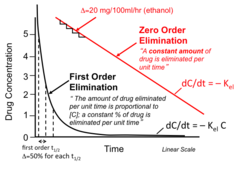
drugs which Concentration in plasma decreases linearly with time.
rate of elimination is constant regardless of Cp (constant amount of drug eliminated per unit time)
zero order elimination
PEA
phenytoin, ETHANOL,ASPIRIN
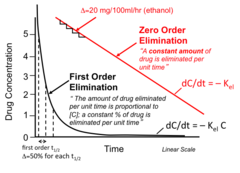
drugs witch decrease exponentially with time.
rate of elimination is directly PROPORTIONAL to the drug concentration!
is a flow dependent elimination.
there a constant Proportion of drug elimined per unit time
First Order elimination
if first order elimination in 2hours 12,5 mg decrease to 10mg, after 2 hours which will be the concentration?
same proportion! 20%
8mg
bacteria mechanism of resistance for ATB
1. penicillinase in bacteria cleaves the blactam ring
penicillins resistant b lactamases (oxa/methi,diclo,nafcillin)
1.
penicilli G,V
amoxicillin, ampicillin(wider spectrum)
Pipera/ticarcillin (anti pseudo) (may combine wit b lactamase inhibitors)
bacteria mechanism of resistance for ATB
2. structural change in penicillin binding ptns (transpeptidases)
cephalosporins
bacteria mechanism of resistance for ATB
3. D ala D ala to D ala d LAC! (VRE)
vancomycin
bacteria mechanism of resistance for ATB
4. bacterial transferase inactivate ATB by acetylation, phosphorilation or adenylation
aminoglycosides
Bacteria mechanism of resistance for ATB
5. decrease or increase efflux out of the bacterial cells by plasmid encoded transport pump.
production of a ptn that allows translation of bacteria to take place even when ATB is present within the bacteria.
tetracycline
bacteria mechanism of resistance for ATB
6. plasmid encoded acetyltransferase inactivates the drug
chloramphenicol
bacteria mechanism of resistance for ATB
7.point mutation of ribossomal RNA
Linezolid
bacteria mechanism of resistance for ATB
8. methylation of 23 S rRna binding of 50s prevents binding of drug
macrolides
bacteria mechanism of resistance for ATB
9.altered enzyme (bacterial dihydropteroate synthase),decreased uptake or PABA synthesis
sulfonamides
mechanism of resistance of mycobacteria::
mutation reduces drug binding to RNA polymerase.(mutation in gene that codes for a DNA dependent RNA polymerase)
Rifamycin
monotherapy leads to resistance
mechanism of resistance of mycobacteria:
mutation leading to underexpression of KatC
Isoniazid
KAT encodes catalase peroxidase needed to convert INH to active metabolite
mechanism of resistance of virus for antiviral
1. mutated (thymidine) viral kinase
cyclovirs
mechanism of resistance of virus for antiviral
2.mutated (CMV) viral kinase
ganciclovir
mechanism of resistance of virus for antiviral
3. mutated DNA polymerase
Foscarnet
does not require activation by viral kinase
characterized by acute noninflammatory encephalopathy (headache,coma) and fatty degenerative liver(hypoglycemia) decreased beta oxidation! due mitochondrial enzymes inhibition!
liver failure after a viral illness, particularly an upper respiratory tract infection, influenza B, varicella, or gastroenteritis,
Reye syndrome
aspirin use!
H1 blockers! generation?
names contains
1. en/ine or en/ate
2.adine
1.
DiphENhydramINE,
DimENhydrATE,
chlorphENiramINE
2. lorat/fexofenadine
H1 blockers clinical use
1generation
2generation
both allergy! (second rhinitis! and less sedating due low penetration in CNS)
but first motion sickness,sleep aid (disrupts), anaphylaxis after stabilization with epinephrine.
expectorants think 2!:
-N acetylcysteine mucolytic!prophylaxis against induced nephropathy if preexisting renal disease.
-Guaifenesin: EXPECTORANT-thin secretions
cough suppression:think
-opioids:inhibits at CNS level (codeine)
DEXTROmethorphan: antagonizes NMDA glutamate receptors), synthetic codeine analog!
mild opioid effect if used in excess:constipation
nasal descongestionants
pseudoephedrine and phenylephrine (alpha adrenergic agonists)
pseu used to makje methamphetamine
AR disease:
q square = prevalence
q = allele frequency
2q = carrier frequency
X-linked AR:
Prevalence = allele frequency
q square = q
Carrier state for females = 2q
the X link disease is seen in 1/100,000 males.which is the expected prevalenve of heterozygous females.
Allele frequency (q) = the prevalence (q square)
Thats why in this question q = 1/100000
Carrier state = 2q = 2/100000 = 1/50000
at the initial screening evidence of clamydia tracomatis infection is founf in 500 of 2500 student .one year later evidence of C tramotis is found in an additional 200 students which of the following is anual incidence of c tracomatis infection in this population of students
B10 %
here is no info about how much students have got the treatment, so consider like a chronic disease. take out people who had the disease in people at risk!
those 500 who already have it aren't at risk anymore to get it.
therefore 200/2000 is the correct answer
flow rate formula:
- flow velocity X cross sectional area
if fv:20cm/sec and cross area:2cm2 remember to convert units is L/Min
ohms law to calculate flow
resistance formula:
- U=R.i
p1-p2=R.Q(flow)
Q= p1-p2/R
R= viscosity/radio4
so: Q=p1-p2 x r4 /viscosity
1. hyperproteinemia styates, polycythemia, hereditary spherocytios increases
2. anemia decreases
viscosity
have highest total cross sectional area and lowest flow velocity
capillaries
organ removal(nephrectomy) leads to
increased TPR and decreased CO
cm 3
1 ml or 10 -3 L
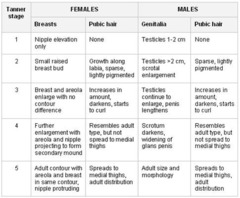
tanner scale
I prepubertal childhood
II 8-13 pubic hair ___________;breast buds________
III pubic hair _________;breast___________;penis increase________
IV penis increase__________;scrotal skin/glans, areola_;
V adult; areola
I prepubertal childhood
II.pubic hair appears(pubarche);breast buds form (thelarche)
III pubic hair: darkens/curly! ;breast enlarge;penis increase size/lengh
IV penis increase width;scrotal skin/glans, areola raise
V adult; areola are no loger raised
irregular mestrual periods 13/14, after menarche
anovulatory cycles
how S pneumoniae ability to produce capsules (his major virulence factor)
bhy transformation!
SHN use this ability to take up fragments of Dna from environment (eg from cell lysis)
transduction generalized "a packaging" event by
litic phage infecting bacterium!cleaves bacterial DNA and parts of both DNA are packaged together in viral capside to infect another bacteria.
transduction specialized is a "excision event" by:
Lytic Phage! infects bacteria, its viral dna is incomporated in bacterial chromosome! when phage DNA is EXCISED, flanking bacterial genes may be excised with it, packaged into viral capside to infect another bacteria.
which bacteria toxins are encoded by lysogenic phage: ABCDE
Shiga
Botulinum
cholera
diphteria
erythrogenci of st pyogenes
the condition may increase the risk for:
Kidney obstruction - abnormal placement of ureter may lead to obstruction and dilation of the kidney.
Kidney infections - associated with vesicoureteral reflux.
Kidney stones - deviant orientation of kidneys combined with slow urine flow and kidney obstruction may lead to kidney stones.
Kidney cancer - increased risk of renal cancer, especially Wilms' tumor, transitional cell carcinoma, and an occasional case report of carcinoid tumor.[3] Despite increased risk, the overall risk is still relatively low.
While most cases of horseshoe kidneys are asymptomatic and discovered upon autops
The prevalence of horseshoe kidneys in females with Turner Syndrome is about 15%.
It can be associated with trisomy 18,13.[5]
whats the LH/FSH ratio in POS?
high LH!
stimulates theca cells to produce androgens
how insulin resistance increase androgens?
stimulates theca cells to produce androgens
whats does high androgens lead?
high conversion in periphery to estrone due aromatase!
androgens are converted to estradiolin granulosa cells?
no, due low FSH!
what does sex binding hormones interfere in level of strogens/androgens in blood?
they are in low quantitity due low production by the liver leading to higher free levels of androgens and estrogens in the blood
all are up less FSH
POS
consequences:
1.high estrogen
2.high androgen
1.amenorrhea/oligo, repeated anovulatory cycles-subfertility;
higher risk of endometrial hyperplasia/cancer due unoposed estrogen.
2.hirsutism,acne
treat POS
weight reduction
OCP
clomiphene
ketokonazol
spironolactone
why acute alcohol intake protects for acetaminophen intake liver injury and chronic alcohol intake worse live injury?
by inhibiting or inducing P450 enzymes to make hepatotoxic metabolites!
oral or depot-injected contraceptive and also as the progestin component of menopausal hormone replacement therapy to prevent endometrial hyperplasia and cancer. is also used as a treatment for endometriosis, dysmenorrhea, and amenorrhea.
decreases growth and increases vascularization of endometrium
progestins (medroxyprogesterone)
adjuvant therapy for postmenopausal women with ER+ breast cancer
exemestane/anastrozole (aromatase inhibitors)
selective estrogen receptor modulators
clomiphene
tamoxifen
raloxifene
antagonist at estrogen receptor in hypothalamus
1 line of infertility due anovulation
prevents normal feedback inhibition and increase release of LH and FSH, which stimulates ovulation.
may cause Hot flashes,ovarian enlargement,multipole pregnancies.
clomiphene
drug to prevent /treat breast cancer (ER+)
(also agonist bone,uterus)
tamoxifen
drug to prevent breast cancer and mainly prevent osteoporosis *agonist bone) but antagonist at uterus!
Raloxifene
DX: men: Low back pain,dysuria,urgency,frequency
prostatitis
CD56, chromogranin, synaptophysin, and neuron-specific enolase) markers from
neuroendocrine origin
bacteria which causes prostatitis
<35 Y
>35Y
<35: N.gonorrhea,chlamydia trac
>35: think UTI ( PEcKS
proteus,E.COLI!!!,Klebsiella,Serratia and enterobacter
prostatitis treat:
fluoroquinolones,levo for >4 weeksor
TMP/SMX
is an activator of the intrinsic coagulations cascade:
Deficiency leads to increased:
Kallikrein
deficienct of kallikrein leads to defective intrinsic pathway which is measured with PTT ( is increased in dysfunction of the intrinsic pathway
B1 selective B antagonists
A to M
Acetabulol (partial agonist),atenolol,esmolol,metoprolol
Non selective B antagonist
N to Z
Nadolol,Pindolol(partial agonist),propranolol,Timolol
non selective B and alpha
labetalol and carvedilol!
weak B1B2 agonis(partial) acts as antagonists
acetabulol,pindolol to HTN patients with bradycardia
non seletive irreversible X reversible Alpha blockers
irreversible (PHEnoxbensamine! to PHEochromocytoma
reversible; give to patients using MAO eating tyramine foods
alpha 1 selective blockers (osin) to BPH
praz,teraz,doxaz,tamsulosim
alpha 1 selective blockers (osin) to BPH which does not lower BP!give for normotense patients
Tamsulosin (selective for Alpha 1 a on Prostate!) does not relax vascular Alpha 1 b receptors on vessels
alpha 2 agonist for ADHD, tourette syndrome
cause CNS depression,bradycardia,hypootension,respiratory depression,miosis.
clonidine
alpha 2 blocher for depression but becomes asleep, fat, hungry!
mirtazapine
alpha 2 agonist for HTN in pregnancy
diect coombs + hemolysis
SLE like syndrome
a methyldopa
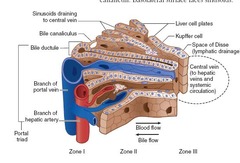
name of zone I affected first by viral hepatitis, ingested toxins
periportal zone
namoe of zone affected by yellow fever
intermediate zone
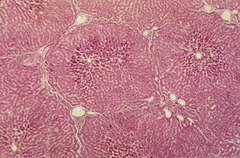
name of zone affected by ISCHEMIA! (high demant of energy by Na/Katpase)contains P450!being most sensible to metabolic toxins! and alcohol!(alcoholic hepatitis)
pericentral vein (centrilobular)
shows micro abscesses within the crypts and depletion of mucus from goblet cells,tenesmus and bloody diarrhea
ulcerative colitis
which drug upregulate LPL(lipoprotein lipase) increasing blood TG clearance
increased cholesterol bile secretion by decreasing bile acid formation (inhibition of cholesterol 7 hydroxilase)
Fibrates
(high risk of cholesterol gallstones0
Myopathy (high risk with statins)
which drug inhibits lipolysis (HSL) at adipose tissues and reduces hepatic VLDL synthesis?
increases HDL perfect drug! but side effects:
Vit B3 Niacin
red,flushed face decreased by NSAIDS
HyperGLYCEMIA!!:(URICEMIA:((
caution use with statins
ezetimibe,Fibrates
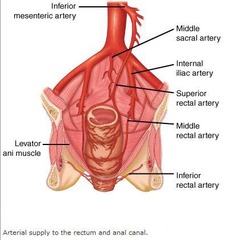
arterial/venous supply above (superior rectum)
under pectinate line (middle/inferior rectum)
above:
-superior RECTAl (a.)(v.) from IM(a.)(v.)
under:
-middle RECTAL (a.) from internal iliac (a.)(v.) directly!
-inferior RECTAL (a.)(v.). from internal pudendal (a.) from internal iliac
A 57 year old man comes to the physician because of a 6 month history of progressive constipation and a feeling of rectal fullness. Digital rectal examination shows no papable lesion. Test of the stool for occult blood is positive. Colonoscopy shows a mass in the sigmoid colon. A biopsy specimen of the mass shows adenocarcinoma. Metastases from this mass will most likely spread via which of the following lymph nodes?
A) Inferior mesenteric
B) Internal iliac
C) Left colic
D) Pararectal
E) Superficial inguinal
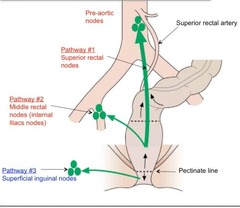
lymphatic drainage
1. above:
(superior rectumXmiddle rectum)
2. under pectinate line
1.above:
-superior rectum: superior RECTAL nodes to IMesenteric
-middle rectal nodes to internal iliac nodes
2. under
-to superficial inguinal nodes
remembre effect of partial agonist in presence of full agonist
antagonist effect
P450 inhibitors
CRACK AMIGOS
Cimetidine
Rito NAVIR
Alcohol use acute
CIPROFLOXACIN
KetoconaAZOLES(fluco/itra..)
AMIODARONE
Macrolides (EXCEP AZITRO!)
Isoniazid
GRAPE FRUIT juice
Omeprazole
SULFA
Quinidine!
gingko biloba
P 450 inducers
Phenytoin
Barbiturates
Chronic alcohol
GRISEOFULVIN
RIFANPIN
St johj
green vegetables/ginseng
substrates for P450
statins
anti epilectics
theophiline
OCPs
Ciclosporine/tacrolimus
rouworms by ingestion EATT
enterobius,ascaris,toxocara, trichinella
roundworms that penetrate skin (SANd)
Strongylois, Ancylostoma/necator
intestinal infection causing vomiting,diahhrea,epigastric pain(fell like peptic ulcer)
strongyloides
intestinal infection causing anemia by sucking blood from intestinal walls
Ancylostoma/necator (hook worms)
At the cell surface, the binding of ligands such as hormones and neurotransmitters to a GPCR activates the receptor by causing a conformational change, which in turn activates the bound:
G protein on the intracellular-side of the membrane. The activated receptor promotes the exchange of bound GDP for GTP
GTP binding changes the conformation of switch regions within the alpha subunit, which allows the bound trimeric G protein (inactive) to be released fromthe receptor, and to dissociate into
active alpha subunit (GTP-bound) and beta/gamma dimer
the alpha subunit and the beta/gamma dimer go on to activate distinct downstream effectors, such:
as adenylyl cyclase, phosphodiesterases, phospholipase C, and ion channels. These effectors in turn regulate the intracellular concentrations of secondary messengers, such as cAMP, diacylglycerol, sodium or calcium cations, which ultimately lead to a physiological response, usually via the downstream regulation of gene transcription
activated receptor promotes the exchange of bound GDP for GTP in which G ptn subunit?
G protein alpha subunit.
The cycle is completed by the hydrolysis of
alpha subunit-bound GTP to GDP, resulting in the re-association of the alpha and beta/gamma subunits and their binding to the receptor
glucagon (fasting) activates which enzyme to get to gluconeogenesis
high glucagon->high cAMP->high Ptn Kinase A which activates FBPase 2(fructose biphosphatase) which converts
Fructose 2,6BP ->Fructose6P (less glycolysis),more gluconeogenesis.
1.glucokinase inhibitor
2.hexokinase inhibitor
3.PFK1 inhibitor X stimuli
4.Pyruvate kinase inhibitorX stimuli
5.Fructose 1,6Bisphosphatase inhibX stimuli
1.fructose 6P
2.glucose 6P
3.Citrate,ATP X Fructose 2,6B,AMP
4.Alanine,ATP X Fructose 1,6B
5. AMP,fructose 2,6BphosphateX AMP,ACETYL COa,Citrate
antiviral drug ciclovirs action.inhibits
DNA polymerase
viral kinase (HSV/VZV) phosphorilates drug and celullar kinase also forming triphosphate which acts:
guanosine analogs (AFV) aci,fam,valacyclovir.
actsinhibiting DNA polymerase
drug which triphosphate is formed by CMV and host cellular kinases and also inhibits DNA polymerase.
also a guanosine analog
Ganciclovir by CMV!
incidence of neutropenia increases with coadministration of ganciclovir with
Zidovudine or SMT TMP
does not require virus (viral kinmase) to be activated! has also DNA and RNA polymerase inhibition action! and HIV transcriptase inhibition
Foscarnet! a pyrophosphate analog
also inhibits DNA polymerase also does not require virus (viral kinmase) to be activated!
cidofovir
use is CMV retinitis in immunocompromissed,acyclovir resistant HSV
foscarnet or cidofovir
prostaglandins produced by COXs
IDE
PGI2,D2,E2 ( vasodilation,increased permeability)
E2 also fever and pain
Leukotrienes produced by 5 Lipoxygenases:
B CDE!
LTC4,D4,E4 (vaso CONSTRICTION,increased permeability also., and BRONCHOSPASM!
LTB4 activate neutrophil
systemic mycosis and treat:
Histo/blasto/coccidio/paracocci
itraconazole;
flucytosine w/wit ampho B
opportunistic
candida/aspergilus/cryptoco/mucor/pneumocystis/sporothrix
candida/crypto/sporot: fluconazole
aspergilus: caspogungins
cutaneous tineas
1.corporis/pedis/ungueal:
2.capitis
1.topical terbinafine
2.oral
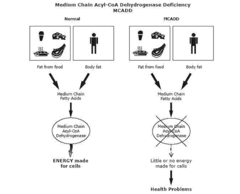
MCAD deficiency

Mcad deficiency
what are the Amino Acids, HC03, Phosphate and Glucose levels
Everything decreased
